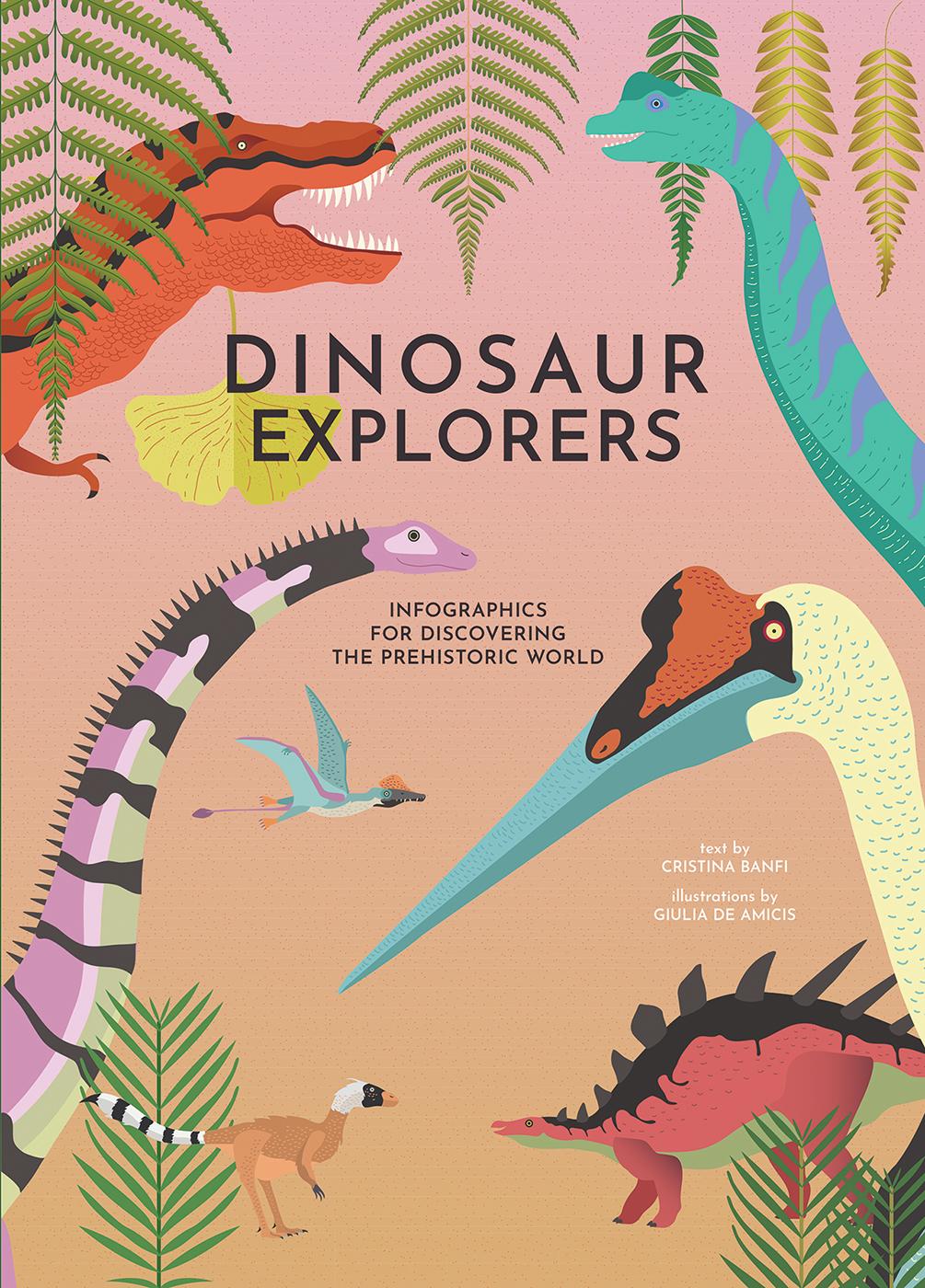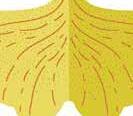






















































































































































Are you crazy about dinosaurs? Are you a fellow sufferer of dinomania? If so, this book is for you, because it will tell you every single detail about your favorite friends. Its pages will bring back to life some of those examples of prehistoric creatures that dominated the Earth millions of years ago and then vanished into the evolution of time. Are you wondering how? Each page is rich with up-to-date information on the look and the lifestyle of the most fascinating Mesozoic reptiles. Down to the numbers, prehistoric animals are compared with present animals, to help you better understand what they looked like, what they ate, how they reproduced and how they behaved
We all know dinosaurs: we usually imagine them as gigantic and scary lizards, as the dominating protagonists of life on Earth of a long gone era. Actually, dinosaurs were very diverse in shape and dimensions and they lived during a long geological era that paleontologists call “Mesozoic”.
The first characteristic is to have lived in the Mesozoic era. All those animals populating the Earth during earlier or later times are certainly not dinosaurs.
Now completely extinct, dinosaurs lived in a period between 245 and 65 million years ago, but not all Mesozoic animals were dinosaurs. They shared their habitats with many animals: other reptiles, mammals, amphibians and invertebrates.
They were not dinosaurs if...
All dinosaurs lived on land.
Even though some dinosaurs were able to swim for short distances, they never lived permanently in lakes, seas or rivers, like for instance cetaceans do.
Those big marine reptiles that also lived in the Mesozoic were not dinosaurs.
Even those reptiles flying across the sky at incredible speed, known as “pterosaurs”, were not dinosaurs.
They flew
They lived in the water like fish
They walked dragging the tail on the ground and with their legs bent
3
Dinosaurs walked on land; their legs were positioned directly under their body, keeping it raised from the ground. Today you can observe the same in mammals and birds. This adaptation made dinosaurs excellent walkers and runners and probably helped them to successfully survive for a very long time.
Diapsids two holes
Synapsids one hole
If we thought this about dinosaurs we would be wrong!
4
All dinosaurs were diapsids, which means that their skull had two holes (or fenestra) behind the eye sockets. These holes made their heads lighter and made room for the development of the masticatory muscles. Many reptiles were synapsids, because they had one hole; others were anapsids, because their skull had no holes at all.
Anapsids no hole
They all had small brains
They all lived in the same period and in the same places They shared the prehistoric era with humans
They spent their time fighting violently
As you surely know, there are no dinosaurs on Earth today.
They haven’t populated our planet for the last 65 million years but there was a time when these animals prospered, occupying all available habitats and playing any ecological role. Paleontologists have called this period of 186 million years MESOZOIC ERA, or simply MESOZOIC.
It lasts 51 million years and begins with a massive extinction, possibly the biggest that has ever occurred. The Earth is almost completely uninhabited: 96 % of marine species and 70% of terrestrial vertebrates have disappeared.
The Earth begins to heat up, so becoming an ideal habitat for reptiles. Amongst Archosaurs, the first dinosaurs make their apperance.
The Mesozoic period (186 million years ) has been divided by paleontologists into 3 shorter periods: Triassic; Jurassic, Cretaceous.
The Earth land mass is concentrated into one continent, the Pangaea, surrounded by an immense ocean, the Panthalassa.
251 mya
mya = millions of years ago 204 mya
Think for a moment: the dinosaurs that lived in the Triassic, such as the vegetarian Plateosaurus, are far more distant in time from the carnivore T-rex (Tyrannosaurus rex) than the T-rex is distant from us!
The inner parts of the Pangaea are very dry: a harsh desert with very little water, where rain-filled clouds brought by the oceanic winds can’t reach.
In this period, primitive amphibians start evolving into much bigger predators.
The supercontinent Pangaea breaks up and apart, creating the Tethys sea. In this period the Earth is filled with insects and the sea is populated by algae, corals and sponges.
Towards the end of this period, a climate change leads to the extinction of a third of the marine species and of most of the amphibians.
The digestive system varied significantly depending whether the dinosaur was a carnivore or a herbivore

In order to collect a good reserve of vegetables, the stomach had to be big, like some kind of big sac to be filled up rapidly, so as to guarantee the biggest possible food intake.
Like modern herbivore birds and crocodiles, some dinosaurs would swallow small stones (called “gastroliths”) to activate a further mastication inside the stomach. The powerful muscles on the walls of the stomach would mix the leaves with the stones, in this way breaking down the vegetables into smaller pieces..
We believe that herbivore dinosaurs had a rather long intestine to allow the slow digestion of plants, which are made of cellulose, a very resistant nutrient that was very hard to digest .


Carnivores probably had a much simpler digestive apparatus, because the digestion of meat is quite fast and doesn’t need to go through many processings. With its small dimensions compared to the whole animal, the intestine was all tucked under the pelvis, so as not to be an obstacle when moving and running.
The information that paleontologists have on the ability of dinosaurs to use thier senses is gathered mainly from studying their skull, and more specifically by analizing the imprint left by their brain on the inside of the skull walls.
It has been possible to infer that there were differences between carnivores and herbivores, especially in regard to their sight: herbivores had eyes on either side of the head - typical of preys - to allow a wider vision of the surroundings and to spot possible approaching predators.

Amongst carnivores, some had quite big eyes facing ahead to allow a stereoscopic vision. This helped them gauge the distance of a prey with accuracy and consequently to adjust their speed for the attack.


We know very little about how dinosaurs could hear. Like modern reptiles and birds, they didn’t have outer ears, whereas the middle and the inner ears were developed.
The olfactory lobe (the part of the brain responsible for the sense of smell) was generally large, leading us to believe that the smell was very important to find food or to recognize individuals of the same species.
Babies probably could hear high-frequency sounds too, like dogs and dolphins, whilst the adults could be sensitive to infra-sounds, that were useful for longdistance communication, similar to elephants and whales.
We can learn about what an animal eats, how it finds food and if it chews it or swallows it whole, by looking at its teeth. And dinosaurs are no exception.


in (19 cm) 4 in (10 cm)
Dinosaurs teeth were replaced several times: the broken and worn-out ones would periodically fall and be substituted by new, sharp ones.
Because there were so many types of dinosaurs, with different shapes and sizes, we can see a great variety of teeth.
The type of food that was eaten determined the shape and the number of teeth of these reptiles; whilst the size of them simply depended on the dimensions of the animal.
However, there were also dinosaurs without a single tooth, and those ones give paleontolgists many questions to answer about what their food was. Some of them, though, had a rigid and sharp beak instead of teeth, and that was enough to tear the leaves apart.


in (19 cm) 5 in (12 cm) 3 in (8 cm)
In some species, the teeth were positioned individually inside the gum, whereas in other species they were numerous and lined up in rows, like the seats of a theater. Their position could be very much at the rear of the mouth or concentrated in the front part.



Predators like the Theropods had pointed teeth: some were straight, others were curved, very often with a serrated edge that would help tear the flesh of the prey apart. Carnivores’ teeth were not suitable for chewing: they were only used to hold the victim in a grip and to break it into pieces, which they then swallowed as a whole, like sharks and crocodiles do.
T-rex’s teeth could reach the size of a banana. They numbered appriximately 50 to 60 and each had a different function depending on their position: the front ones would grab and hold the prey, the lateral ones would tear the flesh, which was then pushed into the throat by the ones at the back.
Conical and non-serrated teeth indicate that the animal fed on fish instead. Spinosaurus, whose teeth resemble those of a crocodile, is an example of this.
T-rex tooth
(scale 1:1)

3 in (7.5cm)
0.4 in (1 cm)
The longest dinosaur tooth ever recorded belonged to T-rex, and it measured 12 in (30 cm)!



exposed part

Within the food chain herbivores are always prey and the same applied to dinosaurs. Being a prey led to the need to develop weapons and defense strategies to survive the carnivores’ attacks. The better these tools were, the higher the chances of survival.
Sauropods could not be attacked because they were huge; but if that wasn’t enough of a deterrent for potential enemies, they would snap their long tail like a whip, keeping the assailant at a distance; a bit like a tamer does with his tigers.
Supersaurus and Brachiosaurus defended themselves with their strong tail
Some species counted simply on a prompt escape and on speed; others, like gnus do, counted on the group, confiding on the number of individuals, according to the motto “strength in numbers”. Others defended themselves by protecting their bodies with armors or by having weapons like horns, claws, clubs and spikes.
Dinosaurs with an armor were called “armored” and the most famous group were Ankylosaurus. We can imagine them approaching like tanks, at a speed no higher that 6 mph (10 km/h), under the heavy shell of their own armor. They were untouchable. PROTECTIVE ARMORS
They were made of strong plates of bone, of various dimensions, known as “osteoderms” or “scutes”; they are common even in some modern animals, such as crocodiles and armadillos.
Their bodies would also be equipped with big knobs or even spikes, often placed even on their face More commonly the spikes were along the sides and their presence was enough to discourage predators from biting on the most delicate parts of their bodies.
Scelidosaurus Stegosaurus
Late Jurassic
Early Jurassic
Only rows of bony scutes on the back
No modern reptile has a defensive tail like that of Ankylosaurus. The big club was positioned at the tip and it was made of several bones, fused together into one piece.
Spikes or plates on the back, spikes on the tail and on the shoulders.
Ankylosaurus
Spikes and plates on the back, spikes on the tail and on the shoulders.
The club tail of Ankylosaurus
Thanks to the powerful muscles, the club was rotated horizontally, from one side to the other. This way the animal could hit the predator with such force to break a leg or the chest, inflicting even lethal internal wounds.
The triangular plates of Stegosaurus
Many dinosaurs, like for instance Stegosaurus, featured a double row of triangular plates along their back; these would start from the neck and run down all the way to the end of the tail.


The spikes of Kentrosaurus were 23 in (60 cm) long
The tail could feature two or four spikes, even 3 ft (1 m) long, which were moved by the tail and so became lethal weapons against the great predators.
There were other spiked dinosaurs, like Bajadasaurus (Bajadasaurus pronuspinax), a 32 ft (10 m) long sauropod found in Argentina. As a protection against predators’ bites, it had long, forwardfacing spines along its neck, which were an extension of the neck vertebrae.
The most famous horned dinosaur is certainly Triceratops, from the Ceratopsidae family, that had three horns. Made of solid bone, they were rooted directly into the skull: the two above the eye sockets were 4 ft (1.2 m) long, with a base diamater of 12 in (30 cm).
4 ft (1.2 m)
Overall the horns would make the head approximately half a ton heavy. Thanks to a specific joint in the skull, Triceratops could make big movements with its head, aiming it easily towards the aggressor and so protecting the rest of its body. According to some theories, the strikes could reach the strength necessary to break through a car!
Triceratops had a large bony frill around the neck as protection for the most delicate parts of its body. In many Ceratopsidae the frill featured proper horns, instead of the usual small osteoderms.
Triceratops would adopt defensive behaviors even towards younger individuals of their group. When under attack, the biggest and strongest individuals would surround the youngest and vulnerables ones, making their long horns face the predators, like musk oxen do today to defend themselves from wolves.
Some species featured a peculiar set of claws on their rear limbs, whose function certainly had to something to do with grabbing the plants the animals fed on.
Iguanodon, for instance, were large herbivores, about 33 ft (10 m) long, that fed on large quantities of leaves: to lower the tree branches they probably used their thumb, which had a super claw, so much bigger and different from the others to be initially mistaken for a horn.
We can assume that this unusual claw could be used as a weapon, if needed during a fight with an aggressor.
However, the most surprising claws belonged to Therizinosaurus, a strange Cretacean dinosaur with claws similar to sickles, that could reach 3 ft (1 m) length - like a human arm. They were very useful to grab leaves but they could also become a weapon to keep predators away.
Unfortunately we are not sure about dinosaurs’ color...the pigments that are responsible for color don’t preserve in mummified skin and certainly not in fossil prints. Many paleontologists, however, believe that dinosaurs - like many modern reptiles - used the color and the pattern of their skin to camouflage and to recognize one another.
We can’t rule out that there could have been dinosaurs that were brightly colored, exactly like some reptiles (for instance, agamas and chameleons). In these cases, the bright and vivid coloring would serve the purpose of attracting a partner or as a warning signal towards intruders coming into their territory.
What functions did the color of the skin have?






camouflage
Shades of brown and green helped with hiding and disappearing against the ground and the leaves. .




























Psittacosaurus was apparently of a dark color on its back and lighter on its abdomen, probably to hide in the shade of the undergrowth, like deer.










When studying scales of different dimensions, a few palentologists theorized that Hadrosaurus were striped like zebras. Such type of coat is very useful for animals that live in a group because it confuses the predators’ sight.















To attract the partner or as a warning signal



To confuse predators
Striped patterns










Plumes are a separate matter. Inside the fossilized plumes scientists found - preserved in a fossilized status too - the melanosomes, which were minuscule structures that are responsible for shades of black, grey, brown and red....
Anchiornis
Its body was covered in black and grey plumes, with white fringes on the wings and a crest of red plumes on its head..


It was covered in orange-brown plumes, whereas its tail was black and white striped..

Serikornis




Its plumage alternated light and dark sections on the wings and on the tail.



It had a black plumage, whilst its head featured yellow/brown plumes. Yi qi



It had black iridescent plumes, like the modern hill myna.









Like reptiles and birds, dinosaurs reproduced by laying eggs. The size, shape and number depended obviously on the species. The characteristics of the eggs, such as their shape and the structure of their shell, can help determine if they were laid by Theropods, Sauropods or other types of dinosaurs.

8 in (21 cm)
Protoceratops

8.4 in (21.5 cm)
Titanosaurus

Female dinosaurs laid up to 20 eggs each time. Many were eaten by predators before hatching.
6 in (15 cm)
Hadrosaurus





Elongated shape
Tetrapods Sauropods, Ornithopoda and other herbivores
Round shape
We can infer that the shape was related to the way the eggs were grouped in the nesting area: the elongated ones were easier to place in smaller places and were more resistant to rolling.

6 in (15 cm)
Oviraptor

16 in (40 cm)
Tarbosaurus

7 in (18 cm)
ostrich egg
No matter how big the mother was, paleontologists can confidently believe that no dinosaur egg has ever been longer than 23 in (60 cm). . The biggest ones require a thicker shell, which however needs to allow the oxygen to enter the egg as needed by the embryo. Therefore, both the thickness and the size can only reach the limit that nature allows. .
The thickest shell ever found was 0.2 in (6 mm) thick. Its surface had holes that correspond to ducts, which allowed the embryo to breathe and gave it the right level of humidity. Their number is specific to each species and can give precious information on how the eggs were laid.
shell thickness 0.09 in (2.3 mm)
laid on the surface

laid underground
The locations where we have found the highest amount of dinosaur eggs are China, Mongolia, Argentina, India and North America.
We don’t know exactly what color the eggs were. Recent studies from Yale University have shown that some species, like many modern birds, laid colorful and patched eggs, perhaps to camouflage them with the environment and mislead predators. It is possible that the eggs laid underground were white, whereas the ones laid on the ground - like Oviraptor did -were pigmented.

Apparently some eggs from the species Heyuannia were actually blue, like the eggs of emus and cassowarries.




















Stained and patched eggs camouflaged with the surroundings.
Not all dinosaurs had a solitary life, quite the opposite! Several finds have shown that some of them appearently lived in groups. Remains of several specimens of the same species have been found, piled up in big settlements. We can infer that entire herds died at the same time, possibly surprised by a cataclysm, such as an earthquake, a sand storm or maybe covered by ashes during a volcanic eruption.
In other cases, they found footprints left by several dinosaurs that were moving together. Actually, many plant-eaters lived and moved in herds, finding food and perhaps even nesting together. The advantage of grouping resided mainly in the herd being able to protect the individuals from predators.
Some herds might have been temporary - formed by dinosaurs that simply gathered in rich grazing lands.
Perhaps dinosaurs of different species made long seasonal migrations together in order to guarantee themselves a meal all year around.
When marching, the little ones would walk in the center of the herd to be protected.
Life as a herd meant walking together and almost certainly ending up stepping on one another’s feet and tails, as shown by bone wounds on some remains.